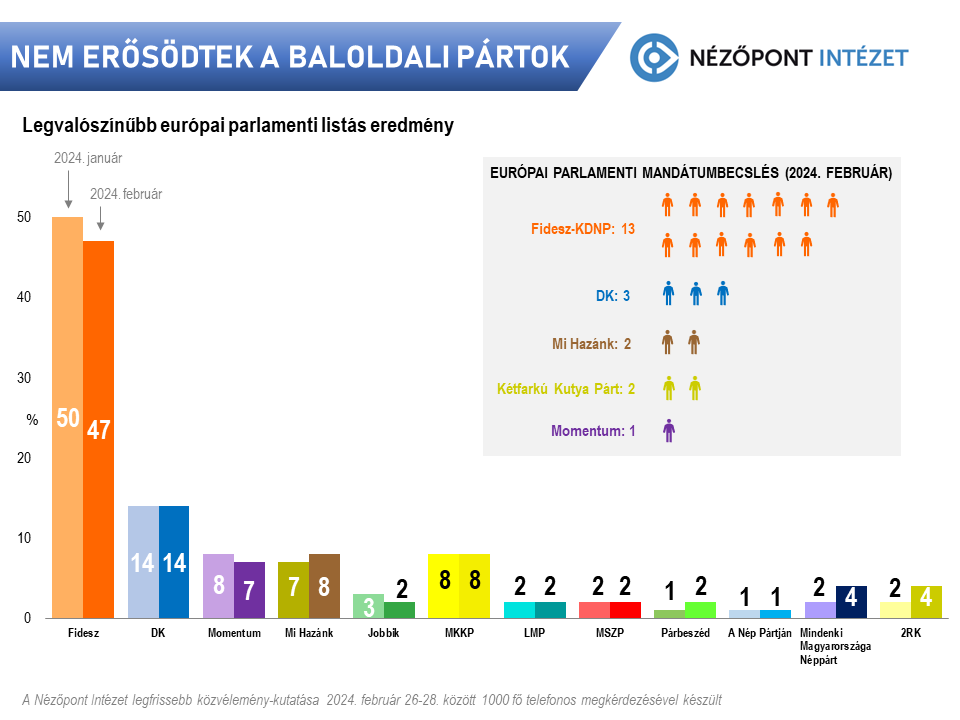Compared to February, Fidesz has maintained its 47-percent lead, but left-wing voters are divided over the emergence of Péter Magyar. According to the latest opinion poll conducted by the Nézőpont Institute, Péter Magyar’s new party (13 percent) is in a tight race with the three-party coalition DK-MSZP-P (13 percent) and the Two-Tailed Dog Party (11 percent). The biggest loser of the change is Momentum, which does not even reach the entry threshold (4 percent).
Péter Magyar announced three weeks ago that he would set up a party to run in the upcoming European Parliament elections which will be held in just over two months. This week’s survey of the Nézőpont Intézet has examined the impact of the new player on the Hungarian political landscape. The picture is clear. While Péter Magyar is trying to position himself as a centre-right party, he has failed to attract voters from the governing parties. His support base mainly consists of the existing voters of the left-wing parties.

If an EP election were held “this Sunday”, Fidesz-KDNP would win 47 percent of the vote, the same amount as estimated in the last poll conducted after the pardon case at the end of February. Although the past two months have not been favourable for the governing parties, the election campaign, which is expected to intensify in the near future, could mobilise even more right-wing sympathisers.
It still seems certain that, in addition to the governing parties and the left-wing opposition, the right-wing opposition could also win seats in Brussels. This week, Mi Hazánk can count on a support of 6 percent (down from 8 percent in February).
13 percent of Hungarians would vote for Péter Magyar’s party in the EP elections, which represents a significant shift in the political landscape in just a few weeks. However, the new party could neither attract undecided or inactive voters, nor could it gain large numbers of supporters from Fidesz. Its voter base is made up of existing left-wing party supporters, so its emergence has caused losses for all left-wing parties.
The technically not yet existing Magyar-party could be the third centre party on the left. The joint list of DK, MSZP and Párbeszéd also has 13 percent support (in the EP elections, joint lists as well only have to reach the 5 percent threshold), while the list of the Dog Party has 11 percent support. This also means that the Gyurcsány coalition has not been strengthened by the inclusion of the two micro-parties, as it achieved the same support without them in February (for the sake of comparability, the February figures for the three organisations were added together retrospectively). The Dog Party, on the other hand, has gained three percentage points in just over a month.
Momentum seems to be the biggest loser of the last month and a half (4 percent, 7 percent in February), which means that instead of the two seats they won in 2019, they would not be able to win a single seat in Brussels today. Thus, the party organised against the Budapest Olympics could lose its importance on the left even before the Paris Olympics and become a player in the league of “additional parties”.
Methodology
The latest opinion-poll of the Nézőpont Institute was conducted between 26 and 28 of February, and between 2 and 4 of April, 2024, by interviewing 1,000 respondents by phone. For all surveys, the sample is representative of the adult population (18 years and older) by gender, age, region, type of settlement and education. In case of a sample size of 1000 respondents and a confidence level of 95 percent, the margin of sampling error is ± 3.16 percent. Party preference figures have been rounded to the nearest whole number, so their sum may not add up to exactly 100. Respondent base = Hungarian voters, respondents who are willing to participate in a European Parliament election.
